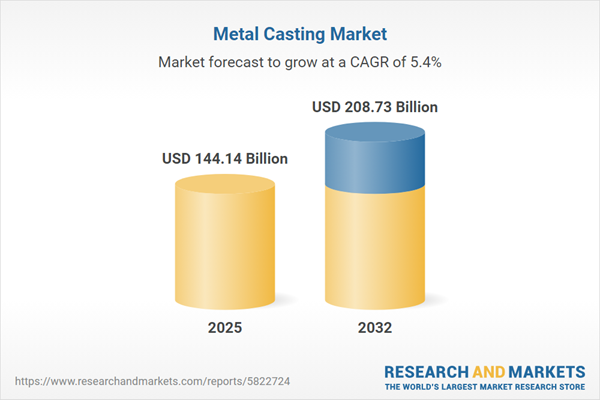Speak directly to the analyst to clarify any post sales queries you may have.
The global metal casting market is entering a new phase as digital transformation and material advancements redefine manufacturing resilience and adaptability for senior executives seeking sustainable, scalable solutions.
Market Snapshot: Metal Casting Market Overview
Driven by ongoing developments in material science and digital manufacturing, the global metal casting market is reshaping core industrial sectors. Automotive, aerospace, energy, and healthcare segments increasingly adopt engineered alloys and automated systems to gain measurable productivity and operational precision. As automation becomes standard, efficiencies improve and compliance with regulatory frameworks is streamlined. This momentum encourages targeted investment in advanced process technologies and positions metal casting as essential to the manufacture of highly customized, performance-critical components. Senior leaders now recognize metal casting as the backbone of flexible, future-ready production strategies.
Scope & Segmentation of the Global Metal Casting Market
This comprehensive report equips senior executives with actionable intelligence for guiding large-scale manufacturing evolution, risk management, and compliance organization. With segmentation reflecting industry realities and regulatory changes, each area below addresses the priorities and challenges shaping the future of the sector:
- Casting Processes: Centrifugal, continuous, hot chamber die, cold chamber die, investment, permanent mold, gravity, low pressure, vacuum die, and sand casting are examined for their operational scalability, flexibility in batch production, and suitability for diverse industrial needs.
- Materials: Aluminum grades, copper-based alloys including brass and bronze, iron-based options such as ductile, grey, malleable, and white iron, magnesium alloys, carbon steels, stainless steels, and zinc alloys are evaluated for their technological compatibility, system weight, endurance, and efficacy in manufacturing complex, high-standard parts.
- End-Use Industries: Aerospace, defense, automotive, construction, electronics, energy, healthcare equipment, and industrial machinery sectors are analyzed for their specific compliance requirements and supply chain demands in the context of modern market pressures.
- Sales Channels: Both aftermarket and OEM procurement paths are covered to assess lifecycle performance, regulatory standards, and the continuity of material flows across diverse supply chain models.
- Regions Covered: The Americas, Europe, Middle East and Africa, and Asia-Pacific regions are compared with attention to regulatory variations, local technology integration, and differing rates of market adoption and growth enablers.
- Profiled Companies: Leading organizations are benchmarked for operational best practices to promote collaboration and sharpen competitive positioning in an evolving global market.
Key Strategic Takeaways for Senior Decision-Makers
- Implementing digital twin technologies and automation enhances operational repeatability, global consistency, and manufacturing reliability, allowing for rapid scaling and improved compliance across multiple production sites.
- Leveraging new alloy formulations creates components with optimized strength-to-weight profiles, supporting advanced industrial uses and addressing rising requirements for performance-focused design.
- Advancing energy-efficient strategies, emissions monitoring, and robust compliance documentation places enterprises at the forefront of current and future sustainability expectations.
- Building a diversified supplier portfolio and securing regional partnerships fortifies supply chains, ensuring stable operations even in the face of shifts in market conditions or policy frameworks.
- Expanding tracking capabilities and strengthening post-sales services creates a foundation for ongoing growth and provides robust defense against shifting competitive dynamics.
Tariff Impact: Navigating Trade & Sourcing Shifts in Metal Casting
Shifting trade policies prompt senior decision-makers to reevaluate sourcing structures, diversify suppliers, and optimize production site locations. Closer alignment with key customers, increased technical rigor, and strategic partnerships are now standard methods to minimize exposure to tariffs and foster operational continuity in changing global trade environments.
Methodology & Data Sources
Analysis for this report integrates executive-level interviews, technical assessments, validated industry data, and transparent supplier reports. Input from sourcing, engineering, and production management ensures findings address practical manufacturing realities and accurately reflect ongoing industry trends.
Why This Metal Casting Market Report Matters
- Thorough segmentation and regional insights align manufacturing priorities with the rapid pace of technological and regulatory change in the sector.
- Systematic peer benchmarking supports the development of resilient supply chains and effective supplier networks.
- Actionable, evidence-based recommendations allow leaders to capitalize on new opportunities and adapt strategies with confidence.
Conclusion
Embracing digital tools, innovative materials, and robust supplier strategies empowers organizations to remain agile and resilient in the evolving metal casting landscape. Sustained focus and strategic investment position businesses for future operational strength and market advantage.
Additional Product Information:
- Purchase of this report includes 1 year online access with quarterly updates.
- This report can be updated on request. Please contact our Customer Experience team using the Ask a Question widget on our website.
Table of Contents
3. Executive Summary
4. Market Overview
7. Cumulative Impact of Artificial Intelligence 2025
Companies Mentioned
The companies profiled in this Metal Casting market report include:- Nemak S.A.B. de C.V.
- Arconic Corporation
- Thyssenkrupp AG
- American Axle & Manufacturing, Inc.
- Ryobi Limited
- Aisin Seiki Co., Ltd.
- Riken Corporation
- Georg Fischer AG
- Bharat Forge Limited
- Tower International, Inc.
Table Information
| Report Attribute | Details |
|---|---|
| No. of Pages | 183 |
| Published | October 2025 |
| Forecast Period | 2025 - 2032 |
| Estimated Market Value ( USD | $ 144.14 Billion |
| Forecasted Market Value ( USD | $ 208.73 Billion |
| Compound Annual Growth Rate | 5.4% |
| Regions Covered | Global |
| No. of Companies Mentioned | 11 |









